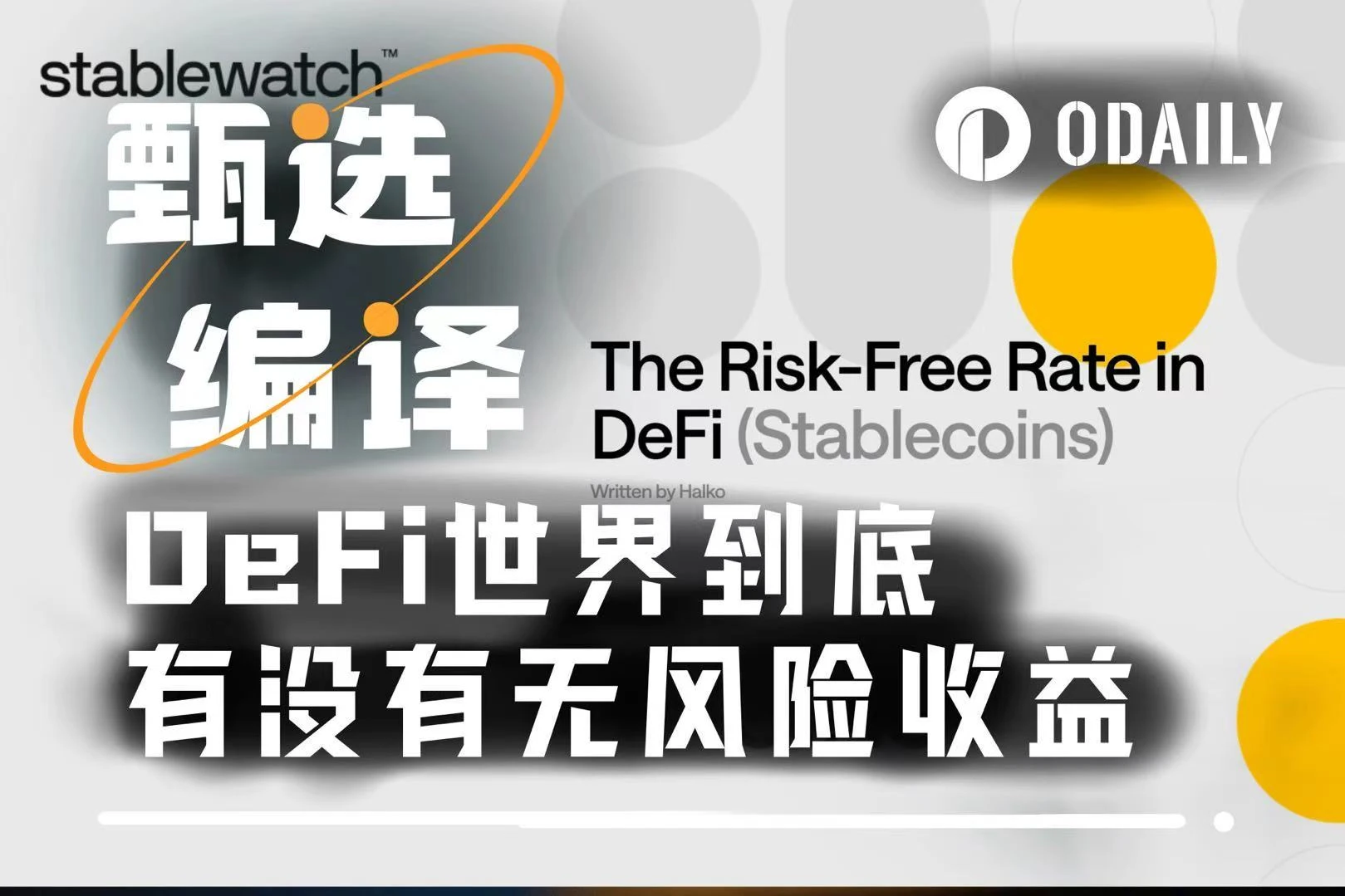This article comes from: stablewatch
Compiled by Odaily Planet Daily ( @OdailyChina ); Translated by Azuma ( @azuma_eth )
Editors note: The DeFi market has not been peaceful recently. First, the popular project USDf was temporarily decoupled due to doubts about its reserve assets and sources of income. Then, the old contract exchange GMX lost more than 40 million US dollars due to hacker attacks (see More than 40 million US dollars were stolen, GMX was accurately ambushed for details). For a while, the market was in a state of panic. In the face of seemingly good returns, the safety of the principal seemed to be more important.
After the incident last night, Sta blewatch published an article titled Is there any risk-free return in the DeFi world? For all users who intend to continue to participate in DeFi, it is necessary to review the underlying risk situation of the market we are in.
The following is the original content of stablewatch, translated by Odaily Planet Daily.

Risk-free rate in DeFi
In traditional finance (TradFi), the risk-free rate is the most commonly used benchmark for investment returns, representing the rate of return that can be achieved without damaging the principal. For example, U.S. Treasury bonds (T-bills) are backed by the credit of the U.S. government, and the U.S. government can print money at will to repay debts (this is also the sacred logic of Bitcoins initial bullishness), but in the wild world of DeFi, the concept of risk-free becomes blurred. Can we find something like a risk-free rate in DeFi? Lets delve into this chaotic world.
Risk-free rate: the cornerstone of traditional finance
Let’s quickly review. In traditional finance, the risk-free rate represents a super-safe benchmark return for investments. For example, why are Treasury bonds “risk-free”? Because the US government will back them with credit, and it can print money to pay off its debts even if inflation soars. This interest rate is the basis of almost all financial models: stock valuations, bond pricing, and DCF analysis done by analysts who stay up all night...all rely on it. You might think that interest rates in traditional finance should be stable and predictable, but this is not the case - there is a discipline called monetary policy that specifically regulates these interest rates, but this deserves a long article in its own right.
Now, let’s see if a similar concept exists in DeFi.
Why is there no true risk-free rate in DeFi?
In DeFi, the risk-free rate is more myth than reality. A senior peer once joked: In DeFi, we are all testing extremely high-risk new financial software with real money. This is absolutely true. Early participants sometimes get rich rewards for taking risks, and sometimes they lose a lot. The charm and curse of the decentralized ecosystem is that it has no traditional safety net - no central bank to back it up, no regulatory protection, no FDIC (Federal Deposit Insurance Corporation) to insure your assets . We designed it with the original intention of exchanging security for the freedom to experiment and innovate, but new entrants must understand that they are facing a complex jungle of risks. Risks also include:
Rug pulls : Projects that promise outrageous returns disappear overnight with the money;
Hacker attacks : Smart contract vulnerabilities can cause even the most secure platforms to lose millions of dollars in an instant;
Cyber threats : North Korean hackers are eyeing DeFi protocols and users as a free lobster buffet;
Then there’s the “code is law” mantra, which is a beautiful concept — transactions are irreversible and cannot be retracted. We’ve seen attackers run away with millions of dollars and claim they “followed the rules of the protocol,” making traditional legal recourse difficult. Despite this, bounty hunters and law enforcement have managed to track down some perpetrators, but only in some cases. In the DeFi market, the boundary between innovation and chaos remains fragile.
But for those who want to maintain as much peace of mind as possible while searching for a basic “safe yield,” what options are there?
“Pseudo-risk-free” income options in DeFi
DeFi is not going to give up easily, and while the perfect risk-free rate is out of reach, there are still several close candidates.
AAVE: This blue-chip lending platform provides relatively reliable single-digit returns through capital supply and demand. It has stood the test of years and is often regarded as a safe haven in DeFi.
Curve Finance: A stablecoin trading empire created by a math geek, it generates revenue through transaction fees (essentially putting money to work), supplemented by CRV token incentives. As one of the few nearly fully decentralized and well-run cases, its token has maintained its value over the past four years. Of course, participating in DAO governance is not a game for the faint of heart.
Tokenized U.S. Treasuries: Platforms such as Ondo and M put U.S. Treasuries on-chain, offering 3-4% Treasury-like returns (2025 data), combining the security of traditional finance with DeFi innovation—although smart contract risks still exist.
These options vary greatly: AAVE’s supply and demand mechanism, Curve’s revenue model that relies on transaction volume, and the “security” of tokenized U.S. Treasuries cannot completely avoid the potential risks of blockchain failures and what DeFi OGs dubbed “crime hotbeds.” Although they are not truly risk-free, they are the best options at the moment.
Who is pouring into the on-chain savings?
This type of “pseudo-risk-free” return attracts several unique types of users.
Non-US investors : Seeking American returns but unwilling to be bound by traditional banks. The previous generation of offshore investors realized cross-border asset allocation by purchasing real estate in London, Vancouver or New York, and now they are turning their funds to DeFi protocols.
Crypto whales : As large cash-outs face real obstacles such as security concerns and tax risks, many people have discovered that on-chain yield farming can not only significantly outperform traditional savings accounts, but also maintain exposure to crypto assets.
The unbanked : With the popularity of mobile wallets, users with unstable local currencies are moving their savings on-chain at a lower cost - in many developing countries, opening a dollar account still faces high fees and bureaucratic barriers.
This trend is breaking through niche circles. On-chain savings, with its accessibility, yield advantages, and ability to solve the limitations of traditional finance, attracts all those who seek alternatives to the banking system. As infrastructure such as mobile wallets continue to evolve, this shift may reshape the financial landscape - the launch of stablecoin plans by institutions such as JPMorgan Chase is a response to market demand.
Interest-bearing stablecoins: a game of risk and reward
Yield-Bearing Stablecoins (YBS) represent a significant evolution in the digital currency space, combining the stability of a dollar anchor with an endogenous yield mechanism. In 2025, some YBS products offer an annualized yield of 6-12%, far exceeding the yield of traditional government bonds. However, these attractive returns require careful evaluation.
High returns come with strings attached. Most returns come from active management, risk-taking, or being the counterparty to someone elses trades. Does it generate significant returns? Yes. But is it risk-free? Not at all.
This raises a fundamental classification question: Are these instruments essentially stablecoins or crypto-themed investment funds? When the yield significantly exceeds the risk-free benchmark such as government bonds, investors have clearly left the risk-free category. The value proposition is still essentially the classic risk-return trade-off: higher return potential must correspond to higher risk exposure.
Analysis of Yield Enhancement Strategies
DeFi protocols often adopt a variety of yield enhancement strategies, each with unique risk characteristics and operating logic.
Real-world asset anchoring (RWA-backed) : Tokenized real-world assets (from government bonds to complex assets such as auto loans and consumer credit) are used as underlying collateral. Some protocols maintain a conservative strategy, while others are involved in high-risk credit markets, exchanging higher default risks for excess returns.
Crypto-backed : Stablecoins are generated through collateralized debt positions (CDPs) on platforms such as Liquity and Abracadabra. They work well in normal markets, but can cause bad debt accumulation and protocol instability when collateral depreciates rapidly.
Stablecoin wrappers (YBS wrappers) : Deploy the basic stablecoin to lending platforms such as AAVE and Euler to obtain benchmark returns, and then wrap the position into a voucher token. These tokens can be mortgaged twice and superimposed with token incentives to form a multi-layered income structure. Although compound value-added can be achieved, the nested relationship between protocols will amplify systemic risks.
Delta Neutral/Synthetic Position Type : Obtain funding rate differences through cross-platform long-short hedging. Profits rely on low-cost position building and spread maintenance, but execution losses and extreme market volatility may make neutral strategies ineffective.
Algorithmic strategy type : The automated system captures market opportunities and adjusts positions in real time. Although it is operationally efficient, it faces the risk of infrastructure failure and algorithm failure.
Actively managed funds : Fund managers make strategic allocations within the DeFi framework, which is actually an on-chain replica of the traditional asset management model. This model not only raises questions about the necessity of smart contract automation, but may also lead to regulatory scrutiny in jurisdictions with strict definitions of decentralization.
Tranched products : Risks are divided into different layers to provide different risk-return combinations for different investors. Investors in the so-called safe layer may become tail risk insurance providers invisibly, and their funds are actually a cushion for extreme losses of the underlying assets.
The Evolving Benefit Paradigm
The above strategies represent the mainstream solutions for current DeFi protocols to enhance stablecoin returns. The programmable nature of decentralized finance will continue to stimulate innovation in revenue mechanisms, heralding the emergence of more complex hybrid strategies and new methodologies in the future. This dynamic evolution not only broadens the boundaries of financial engineering, but also requires investors to establish a more sophisticated risk assessment framework - in the maze of on-chain returns, the highlighted APR number may only be the starting point of the risk coordinate system rather than the end point.
Core conclusion: The high-risk nature of DeFi
The key insights we came to are as follows:
There is no true risk-free rate in DeFi;
Tokenized U.S. debt is closest to risk-free, but it is by no means indestructible;
On-chain lending rates implement an independent price discovery mechanism;
Interest-bearing stablecoins trade stability for returns, and are more like on-chain market-neutral hedge funds than savings accounts.
Return strategies have varying risks – the higher the return, the greater the risk.
Does the high-risk nature of DeFi constitute a fatal flaw? Not necessarily. After all, the crypto community has always been striving to open up its own territory outside the traditional financial system. High returns do exist, but they always come at a price. Therefore, before investing your savings in any interest-bearing product, please remember that carefully checking the on-chain data and bearing your own risks is always the first creed of DeFi.










